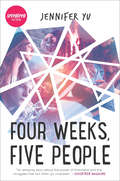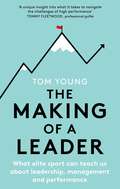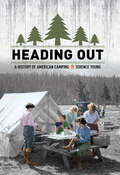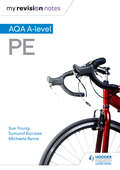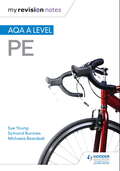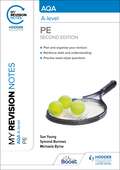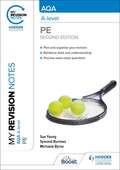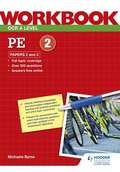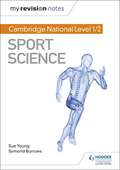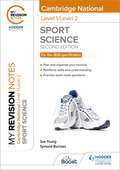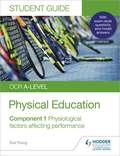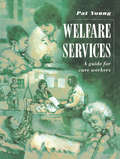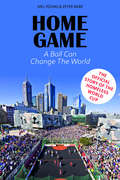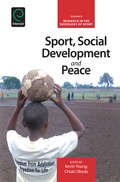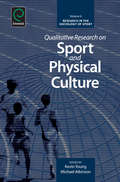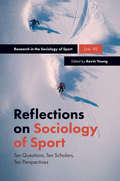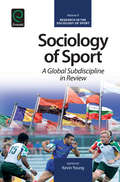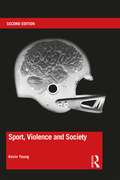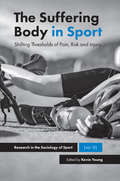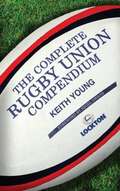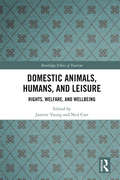- Table View
- List View
The Making of a Leader: What Elite Sport Can Teach Us About Leadership, Management and Performance
by Tom YoungFrom polar explorers and politicians to CEOs and sports coaches, we are fascinated with the makeup of leaders. How do they thrive under pressure and inspire others to do the same? How do they establish a culture of long-term success?Performance psychologist Tom Young has worked closely with teams and individuals at the highest level of professional sport. He has seen how leaders in these high-pressure environments communicate, how they maintain focus and respond to challenges. In The Making of a Leader, Young shares the practical principles of sustained elite performance and shows how any individual can add value to their own business or organisation by applying these insights.You will learn how to develop a leadership philosophy that is true to your values, effectively manage and get results from individuals and teams, establish a high-performance culture and bring value to your organisation - in short, the ingredients that make a leader. These lessons are based on interviews with:- Stuart Lancaster, current Leinster coach and former Head Coach of the England national RFU team- Ashley Giles, ECB Director of Cricket during England's 2019 World Cup win- Gary Kirsten, record-breaking former international batsman and World Cup-winning coach of the Indian national team- Dan Quinn, Head Coach of Atlanta Falcons and a Super Bowl winner with Seattle Seahawks- Roberto Martinez, FA Cup-winner and Belgian national team manager - Sean Dyche, Burnley FC manager- Michael Maguire, Head Coach of the New Zealand national rugby league team The Making of a Leader is a unique, inspiring guide to leadership that can inspire positive results in any context, based on interviews and experiences from the cutting edge of elite sport.---'Offers fascinating insight into man management and the attributes needed to be an effective leader, which is incredibly useful and relevant to me ahead of captaining the 2020 European Ryder Cup team' - Pádraig Harrington, three-time Major champion and captain of the 2020 European Ryder Cup team'Although elite athletes understand the keys to excellence, you rarely have the chance to get inside their heads. You're in luck: Tom Young has solved that problem. As a performance psychologist, he's worked closely with some of the world's best in both individual and team sports. In this fascinating book, he shares his rich experiences and his keen insights on the science - and the practice - of achieving and sustaining success' - Adam Grant, New York Times bestselling author of Originals and Give and Take, and host of the chart-topping TED podcast WorkLife'I am always looking to learn from other sports and this book gives a unique insight into what it takes to navigate the challenges of high performance' - Tommy Fleetwood, professional golfer'This book shows that in the world of professional sport these proven and renowned leaders all have their own rules of strategy, which have brought continued success and recognition' - Alastair Campbell, bestselling author, strategist, broadcaster and lifelong fan of Burnley FC'Full of important lessons that you learn as a leader in sport that are as applicable to business environments as they are to elite sports' - Sir Bill Beaumont, chairman of World Rugby and former England and British & Irish Lions captain'The Making of a Leader provides a unique insight into the inner workings of established leaders' minds. Well worth a read to gain useful leadership intel' - Rebecca Symes, sports psychologist, The FA and England Lionesses'If you want to be a leader or become a better leader, man or woman, in sport or any other sector, this book is for you' - Professor Andy Hargreaves, Professor Emeritus, Boston College and author of Uplifting Leadership
Heading Out: A History of American Camping
by Terence YoungWho are the real campers? Through-hiking backpackers traversing the Appalachian Trail? The family in an SUV making a tour of national parks and sleeping in tents at campgrounds? People committed to the RV lifestyle who move their homes from state to state as season and whim dictate? Terence Young would say: all of the above. Camping is one of the country's most popular pastimes—tens of millions of Americans go camping every year. Whether on foot, on horseback, or in RVs, campers have been enjoying themselves for well more than a century, during which time camping’s appeal has shifted and evolved. In Heading Out, Young takes readers into nature and explores with them the history of camping in the United States.Young shows how camping progressed from an impulse among city-dwellers to seek temporary retreat from their exhausting everyday surroundings to a form of recreation so popular that an industry grew up around it to provide an endless supply of ever-lighter and more convenient gear. Young humanizes camping’s history by spotlighting key figures in its development and a sampling of the campers and the variety of their excursions. Readers will meet William H. H. Murray, who launched a craze for camping in 1869; Mary Bedell, who car camped around America for 12,000 miles in 1922; William Trent Jr., who struggled to end racial segregation in national park campgrounds before World War II; and Carolyn Patterson, who worked with the U.S. Department of State in the 1960s and 1970s to introduce foreign service personnel to the "real" America through trailer camping. These and many additional characters give readers a reason to don a headlamp, pull up a chair beside the campfire, and discover the invigorating and refreshing history of sleeping under the stars.
AQA A-Level PE - My Revision Notes (PDF)
by Sue Young Symond Burrows Michaela ByrneTarget success in PE with this proven formula for effective, structured revision; key content coverage is combined with exam-style tasks and practical tips to create a revision guide that students can rely on to review, strengthen and test their knowledge. With My Revision Notes, every student can: - Plan and manage a successful revision programme using the topic-by-topic planner- Consolidate subject knowledge by working through clear and focused content coverage- Test understanding and identify areas for improvement with regular 'Now Test Yourself' tasks and answers- Improve exam technique through practice questions, expert tips and examples of typical mistakes to avoid - Get exam ready with extra quick quizzes and answers to the practice questions available online
My Revision Notes: AQA A-level PE (My Revision Notes)
by Sue Young Symond Burrows Michaela ByrneTarget success in PE with this proven formula for effective, structured revision; key content coverage is combined with exam-style tasks and practical tips to create a revision guide that students can rely on to review, strengthen and test their knowledge.With My Revision Notes, every student can:Plan and manage a successful revision programme using the topic-by-topic plannerConsolidate subject knowledge by working through clear and focused content coverageTest understanding and identify areas for improvement with regular 'Now Test Yourself' tasks and answersImprove exam technique through practice questions, expert tips and examples of typical mistakes to avoidGet exam ready with extra quick quizzes and answers to the practice questions available online
My Revision Notes: AQA A-level PE Second Edition
by Sue Young Symond Burrows Michaela ByrneSet your students on track to achieve the best grade possible with My Revision Notes. Our clear and concise approach to revision will help students learn, practise and apply their skills and understanding. Coverage of key content is combined with practical study tips and effective revision strategies to create a guide that can be relied on to build both knowledge and confidence.My Revision Notes for AQA A-level PE will help students:- Consolidate knowledge with clear, concise and relevant content coverage, based on what examiners are looking for- Extend understanding with our regular 'Now test yourself,' tasks and answers- Improve technique through our increased exam support, including exam-style practice questions, expert tips and examples of typical mistakes to avoid- Identify key connections between topics and subjects with our 'Making links' focus and further ideas for follow-up and revision activities- Plan and manage a successful revision programme with our topic-by-topic planner, new skills checklist and exam breakdown features, user-friendly definitions, glossary and online questions and answers
My Revision Notes: AQA A-level PE Second Edition
by Sue Young Symond Burrows Michaela ByrneSet your students on track to achieve the best grade possible with My Revision Notes. Our clear and concise approach to revision will help students learn, practise and apply their skills and understanding. Coverage of key content is combined with practical study tips and effective revision strategies to create a guide that can be relied on to build both knowledge and confidence.My Revision Notes for AQA A-level PE will help students:- Consolidate knowledge with clear, concise and relevant content coverage, based on what examiners are looking for- Extend understanding with our regular 'Now test yourself,' tasks and answers- Improve technique through our increased exam support, including exam-style practice questions, expert tips and examples of typical mistakes to avoid- Identify key connections between topics and subjects with our 'Making links' focus and further ideas for follow-up and revision activities- Plan and manage a successful revision programme with our topic-by-topic planner, new skills checklist and exam breakdown features, user-friendly definitions, glossary and online questions and answers
OCR A Level PE Workbook: Paper 2 and 3
by Sue Young Symond Burrows Michaela Byrne- Actively develops knowledge and the ability to recall information with consolidation questions and short topic summaries. - Reinforces understanding and boosts confidence with exam-style practice questions and clear spotlight of the Assessment Objectives. - Encourages independent learning as students can use the Workbook at home or in class, throughout the course or for last-minute revision, with answers to tasks and activities supplied online.
My Revision Notes: Cambridge National Level 1/2 Sport Science (My Revision Notes)
by Sue Young Symond BurrowsEnhance your students' practical skills and develop their key content knowledge with this proven formula for effective, structured revision.Target success in the Cambridge National in Sport Science with this revision guide that brings together exam-style questions, revision tasks and practical tips to help students to review, strengthen and test their knowledge.With My Revision Notes, every student can:- Enjoy an interactive approach to revision, with clear topic summaries that consolidate knowledge and related activities that put the content into context.- Plan and manage a successful revision programme using the topic-by-topic planner.- Build, practise and enhance exam skills by progressing through revision tasks and Test Yourself activities.- Improve exam technique through exam-style questions and sample answers with commentary from an expert author and teacher.- Get exam-ready with answers to the activities available online.
My Revision Notes: Level 1/Level 2 Cambridge National in Sport Science: Second Edition
by Sue Young Symond BurrowsSet students on track to achieve the best grade possible with My Revision Notes.Our clear and concise approach to revision will help students learn, practise and apply their skills and understanding. Coverage of key content is combined with practical study tips and effective revision strategies to create a guide that can be relied on to build both knowledge and confidence.My Revision Notes for Cambridge National Level 1/Level 2 in Sport Science (J828) will help students:- Consolidate knowledge with clear, concise and relevant content coverage, based on what examiners are looking for- Extend understanding with our regular 'Now Test Yourself', tasks and answers- Improve technique through our increased exam support, including exam-style practice questions, expert tips and examples of typical mistakes to avoid- Identify key connections between topics and subjects with our 'Making Links' focus and further ideas for follow-up and revision activities- Plan and manage a successful revision programme with our topic-by-topic planner, new skills checklist and exam breakdown features, user-friendly definitions and glossary
OCR A-level Physical Education Student Guide 1: Physiological factors affecting performance
by Sue YoungReinforce students' understanding of applied anatomy, physiology, exercise physiology and biomechanics and improve their exam technique for component 1: physiological factors affecting performance by utilising this OCR A Level PE Student Guide. Packed full of clear topic summaries, knowledge-check questions and sample exam-style questions and answers with commentaries, this guide will help your students aim for and achieve the highest grades.- Identify key content for the exams with our concise coverage of topics- Find out what examiners are looking for with our Questions and Answers section- Test students' knowledge with rapid-fire knowledge check questions and answers- Avoid common pitfalls with clear definitions and exam tips throughout- Reinforce learning with bullet-list summaries at the end of each section
Welfare Services: A guide for care workers
by Pat Young`An excellent book with a precise usefulness and excellent price. It covers almost precisely the breadth of content needed for practical day-by-day social work.' - Community College Lecturer A guide to welfare services and rights for workers in the care sector. This book gives basic information on six major areas: housing, health, finance, daily living, employment, and children and relates that information to care in practice through a large range of varied activities and case studies. The book is suitable for workers in the care sector, for those preparing for assessment for an NVQ/SVQ award up to and including level 3, for students taking BTEC, City & Guilds or CCETSW courses, and for those on in-service training.
Home Game: The story of the Homeless World Cup
by Mel Young Peter BarrAn estimated 100 million people worldwide are homeless.1.6 billion live in sub-standard housing.But how can such a simple game like football tackle such a complex problem? Mel Young and Peter Barr tell the story of the million homeless people in 70 countries who have taken part in the Homeless World Cup since it was founded in 2003 and the positive impact it has on the players and everyone else involved, including spectators. From refugees to drug addicts, orphans and the poorest of the poor, to homeless people from the world's richest countries, we read about the moving human drama behind the event and find out how a ball can change the world.Home Game provides an insight into the birth of the Homeless World Cup and how it has become such a global phenomenon, by looking at more than just facts. It shows how the power of sport can help excluded people transform their own lives and how the event has transformed attitudes to homelessness.
Sport, Social Development and Peace (Research in the Sociology of Sport #8)
by Kevin Young Chiaki OkadaIn recent years, sport has attracted considerable attention as an effective means of combating such local and global issues as war and conflict, poverty, ethnic reconciliation, and gender conflicts. Sport has been shown to be an effective tool or triggering device compared to the other development sectors, especially when donors can apply grassroots activities to the development contexts in thoughtful and continuing ways. This book fills the gap in this critical topic- that will only grow more important as governments, sport and national organizations direct more funds towards forms of play, PE and sport in the hope that these will represent one way of coalescing communities and assist development and peace. This volume is part of the early serious and systematic inquiry into this issue. In addition to showcasing some of the most recognized names in the research subfield of Sociology of Sport, the book draws upon an international roster of global contributors. The empirical focus of the chapters spans from Africa to Asia. Further, these chapters represent three groups - theory and philosophy, empirical research in actual 'on-the-ground' case studies, and those using circumspection and care to construct cases regarding measurement and evaluation.
Qualitative Research on Sport and Physical Culture (Research in the Sociology of Sport #6)
by Kevin Young Michael AtkinsonThis volume takes a fresh approach to qualitative research on sport and physical culture by presenting "student friendly" engaging chapters that clearly articulate the significance and practice of qualitative and/or critical methods in plain and convincing language. It outlines contemporary, cutting-edge approaches in qualitative research methods that students in undergraduate programs in sociology and sociology of sport, as well as, for instance, sport, exercise, kinesiology, or health, can understand clearly. Chapters revolve around one principal method in qualitative methodology, and look at why certain methodological choices were made, what problems were faced, and how these were overcome. Classic issues in methodology, contemporary issues in research methods and innovative trends in qualitative research are addressed through case study examples from emerging and exciting areas of research in sport studies. Topics covered include: historical methods; ethnography; auto-ethnography; embodied methods; interviewing; narratives; participatory action methods; interpretative phenomenological analysis; media analysis; and visual methods.
Reflections on Sociology of Sport: Ten Questions, Ten Scholars, Ten Perspectives (Research in the Sociology of Sport #10)
by Kevin YoungIn this tenth and celebratory volume in the Research in the Sociology of Sport series, ten recognized and influential sport scholars from around the world reflect on their respective academic journeys. They each address ten salient questions summarizing their career and their view of the current and future status of the sociology of sport. Each chapter addresses four main themes: About the author: who are your mentors and influential figures? What is your research trajectory? About sport: why does sport matter? How should sport be studied? Is sport a panacea for social problems? About practising sociology of sport: is teaching sociology of sport easy? Do sociologists like sport? Is the sociologist of sport a ‘public intellectual? About sociology of sport in the academy: does sociology of sport face institutional or industry barriers? What is the future of the sociology of sport? While the ten questions are salient for everyone in the academy irrespective of field of study, they seem particularly trenchant for sociologists of sport as the subfield reaches a chronological milestone and continues to undergo its own ‘growing pains’ and maturation. Following quickly on the heels of, and conceptually tied to, Volume 9 (Sociology of Sport: A Global Subdiscipline in Review), Volume 10 now completes the ‘double celebration’ of this book series as the sociology of sport subfield turns 50.
Reflections on Sociology of Sport: Ten Questions, Ten Scholars, Ten Perspectives (Research in the Sociology of Sport #10)
by Kevin YoungIn this tenth and celebratory volume in the Research in the Sociology of Sport series, ten recognized and influential sport scholars from around the world reflect on their respective academic journeys. They each address ten salient questions summarizing their career and their view of the current and future status of the sociology of sport. Each chapter addresses four main themes: About the author: who are your mentors and influential figures? What is your research trajectory? About sport: why does sport matter? How should sport be studied? Is sport a panacea for social problems? About practising sociology of sport: is teaching sociology of sport easy? Do sociologists like sport? Is the sociologist of sport a ‘public intellectual? About sociology of sport in the academy: does sociology of sport face institutional or industry barriers? What is the future of the sociology of sport? While the ten questions are salient for everyone in the academy irrespective of field of study, they seem particularly trenchant for sociologists of sport as the subfield reaches a chronological milestone and continues to undergo its own ‘growing pains’ and maturation. Following quickly on the heels of, and conceptually tied to, Volume 9 (Sociology of Sport: A Global Subdiscipline in Review), Volume 10 now completes the ‘double celebration’ of this book series as the sociology of sport subfield turns 50.
Sociology of Sport: A Global Subdiscipline in Review (Research in the Sociology of Sport #9)
by Kevin YoungThe Sociology of Sport has grown since its inception in the late 1950s and has become robust, and diverse. Many countries now boast strong scholars in the field and this volume reflects the fascinating research being done. This innovative volume is dedicated to a review of the state of the area by region, and country in some cases. For instance, Latin America is expanding widely in the field, and Korea and Japan have had vibrant Sociology of Sport communities for some time.
Sport, Violence and Society: Second edition
by Kevin YoungIn this fully updated and revised new edition of his landmark study of violence in and around contemporary sport, Kevin Young offers a comprehensive sociological analysis of an issue of central importance within sport studies. The book explores organised and spontaneous violence, both on the field and off, and calls for a much broader definition of ‘sports-related violence’, to include issues as diverse as criminal behaviour by players, abuse within sport and exploitative labour practices. Offering a sophisticated theoretical framework for understanding violence in a sporting context and including new case studies and updated empirical data – from professional soccer in Europe to ice hockey in North America – the book establishes a benchmark for the study of violence within sport and wider society. Through close examination of often contradictory trends, from anti-violence initiatives in professional sports leagues to the role of the media in encouraging hyper-aggression, the book throws new light on our understanding of the socially-embedded character of sport and its fundamental ties to history, culture, politics, social class, gender and the law. This new edition also recognises burgeoning new literatures, such as research examining concussion and the link between sport and mental illness and includes student-friendly pedagogical aids, such as critical thinking questions at the end of each chapter. Sport, Violence and Society is a vital read for anyone studying or working in the areas of the Sociology of Sport, Sport Psychology, Ethics and Philosophy of Sport, Sport and Politics, Sports History, and Sport and the Media.
Sport, Violence and Society: Second edition
by Kevin YoungIn this fully updated and revised new edition of his landmark study of violence in and around contemporary sport, Kevin Young offers a comprehensive sociological analysis of an issue of central importance within sport studies. The book explores organised and spontaneous violence, both on the field and off, and calls for a much broader definition of ‘sports-related violence’, to include issues as diverse as criminal behaviour by players, abuse within sport and exploitative labour practices. Offering a sophisticated theoretical framework for understanding violence in a sporting context and including new case studies and updated empirical data – from professional soccer in Europe to ice hockey in North America – the book establishes a benchmark for the study of violence within sport and wider society. Through close examination of often contradictory trends, from anti-violence initiatives in professional sports leagues to the role of the media in encouraging hyper-aggression, the book throws new light on our understanding of the socially-embedded character of sport and its fundamental ties to history, culture, politics, social class, gender and the law. This new edition also recognises burgeoning new literatures, such as research examining concussion and the link between sport and mental illness and includes student-friendly pedagogical aids, such as critical thinking questions at the end of each chapter. Sport, Violence and Society is a vital read for anyone studying or working in the areas of the Sociology of Sport, Sport Psychology, Ethics and Philosophy of Sport, Sport and Politics, Sports History, and Sport and the Media.
The Suffering Body in Sport: Shifting Thresholds of Pain, Risk and Injury (Research in the Sociology of Sport #12)
by Kevin YoungPublic awareness of and sensitivity to questions of pain, risk and injury in sport is more acute than ever before. Whether it is questions of what sport (and fans) can realistically and responsibly expect of athletes, how revered practices almost inevitably culminate in suffering bodies, or the widespread attention being paid to injury outcomes (especially concussion), it is clear that sport in many settings currently operates in a climate that is both more scientifically and medically aware and more sensitive to risk 'outcomes'. This volume closely explores the full panorama of pain, risk and injury in the cultural, organizational and legal orbits of sport spaces. Aimed at students, researchers as well as applied professionals, the volume sets the cultural, structural and organizational context that gives rise to pain, risk and injury in the first place, provides substantive empirical examples from diverse sports arenas, looks at the key issues and dimensions of pain, risk and injury in the social consciousness today, and explores three different 'spins' on making sense of the subject matter -- from the position of the issue of consent and the courts, from the position of exploitation and corporate victimization, and from the understudied position of why athletes exit sport as an outcome of pain and injury and with what consequences. This timely and needed addition to the sport literature is an exciting 'on-the-bubble' treatment of a topic that is increasingly troubling authorities and affecting how and whether sport is undertaken.
The Suffering Body in Sport: Shifting Thresholds of Pain, Risk and Injury (Research in the Sociology of Sport #12)
by Kevin YoungPublic awareness of and sensitivity to questions of pain, risk and injury in sport is more acute than ever before. Whether it is questions of what sport (and fans) can realistically and responsibly expect of athletes, how revered practices almost inevitably culminate in suffering bodies, or the widespread attention being paid to injury outcomes (especially concussion), it is clear that sport in many settings currently operates in a climate that is both more scientifically and medically aware and more sensitive to risk 'outcomes'. This volume closely explores the full panorama of pain, risk and injury in the cultural, organizational and legal orbits of sport spaces. Aimed at students, researchers as well as applied professionals, the volume sets the cultural, structural and organizational context that gives rise to pain, risk and injury in the first place, provides substantive empirical examples from diverse sports arenas, looks at the key issues and dimensions of pain, risk and injury in the social consciousness today, and explores three different 'spins' on making sense of the subject matter -- from the position of the issue of consent and the courts, from the position of exploitation and corporate victimization, and from the understudied position of why athletes exit sport as an outcome of pain and injury and with what consequences. This timely and needed addition to the sport literature is an exciting 'on-the-bubble' treatment of a topic that is increasingly troubling authorities and affecting how and whether sport is undertaken.
The Complete Rugby Union Compendium
by Keith YoungDetailing every Test match ever played by the top ten international teams (Argentina, Australia, England, France, Ireland, Italy, New Zealand, Scotland, South Africa and Wales) as well as histories and head-to-head statistics for the second and third tier international teams (Canada, Fiji, Georgia, Japan, Namibia, Romania, Russia, Samoa, Tonga, the United States of America and Uruguay), The Complete Rugby Union Compendium is the definitive source of statistical information on Test match rugby union. With over 5,700 entries presented in a visually engaging format, this book also features over 100 facts and anecdotes from more than a century of rugby union and includes fascinating trivia on the Rugby World Cup, global stadia, trophies, tournaments and competitions. In this unique guide, Keith Young has created a veritable treasure trove for all rugby enthusiasts.
Domestic Animals, Humans, and Leisure: Rights, Welfare, and Wellbeing (Routledge Research in the Ethics of Tourism Series)
by Janette Young Neil CarrDomestic animals are an integral component of human leisure experience and can enhance the physical, social, and mental wellbeing of humans. The interplay of human and animal experiences of justice, wellbeing, rights, and roles within leisure is the central theme of this book. Research explores the position of domesticated animals in human leisure experiences, in a wide array of leisure settings. Chapters question whether domestic animals may have a desire for leisure that is different from human leisure, whether animals have and wish to fulfil needs for meaningful leisure or non-leisure, and whether human leisure needs and desires may coincide or contradict wellbeing interests of animals. This book provides a venue for the dissemination and exploration of research, which champions the welfare and rights of these animals to have their needs and interests in leisure recognised. It moves the debate about animals in leisure beyond the current limits which have seen research mainly confined to the exotic ‘other’ rather than more mundane, everyday domestic animals. This book will be of interest to individuals in the fields of tourism ethics, zoology, animal behaviour, and leisure studies.
Domestic Animals, Humans, and Leisure: Rights, Welfare, and Wellbeing (Routledge Research in the Ethics of Tourism Series)
by Janette Young Neil CarrDomestic animals are an integral component of human leisure experience and can enhance the physical, social, and mental wellbeing of humans. The interplay of human and animal experiences of justice, wellbeing, rights, and roles within leisure is the central theme of this book. Research explores the position of domesticated animals in human leisure experiences, in a wide array of leisure settings. Chapters question whether domestic animals may have a desire for leisure that is different from human leisure, whether animals have and wish to fulfil needs for meaningful leisure or non-leisure, and whether human leisure needs and desires may coincide or contradict wellbeing interests of animals. This book provides a venue for the dissemination and exploration of research, which champions the welfare and rights of these animals to have their needs and interests in leisure recognised. It moves the debate about animals in leisure beyond the current limits which have seen research mainly confined to the exotic ‘other’ rather than more mundane, everyday domestic animals. This book will be of interest to individuals in the fields of tourism ethics, zoology, animal behaviour, and leisure studies.
